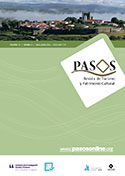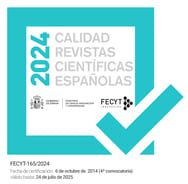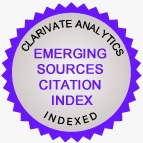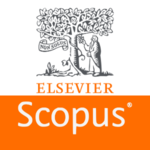Girona como estudo de caso: Cenários do turismo patrimonial na transição pré-COVID-19 para o pós-Pandemia
DOI:
https://doi.org/10.25145/j.pasos.2025.23.033Palavras-chave:
Pré-COVID, pós-COVID, pandemia, crise, cidade patrimónioResumo
Este artigo explora a evolução do turismo na cidade histórica de Girona, abrangendo o período desde antes da pandemia da COVID19 até à era pós-COVID. Através da análise de diversas variáveis, observam-se mudanças significativas na cidade: de um período sustentado de crescimento do turismo a um declínio acentuado devido à crise sanitária, seguido de uma recuperação gradual que começou em maio de 2021. Para além da flutuação das chegadas de turistas, o estudo aprofunda a forma como a pandemia impactou outros sectores relacionados, como o alojamento, a restauração e o comércio, com especial enfoque em eventos-chave como o Festival Temps de Flors e a Temporada Alta, que desempenharam um papel crucial na reativação do turismo local. Este artigo fornece dados empíricos e uma análise que não só reflectem a resiliência de Girona face à crise, como também oferecem conhecimentos valiosos para a gestão do turismo urbano em contextos de crise e recuperação.
Downloads
##plugins.generic.pfl.publicationFactsTitle##
##plugins.generic.pfl.reviewerProfiles## Indisp.
##plugins.generic.pfl.authorStatements##
##plugins.generic.pfl.indexedIn##
-
##plugins.generic.pfl.indexedList##
- ##plugins.generic.pfl.academicSociety##
- PASOS. Revista de Turismo y Patrimonio Cultural
- ##plugins.generic.pfl.publisher##
- Instituto Universitario de Investigación Social y Turismo. Universidad de La Laguna (España) - Instituto Universitario da Maia ISMAI (Portugal)
Referências
Bae, S. Y., & Chang, P. J. (2021). The effect of coronavirus disease-19 (COVID-19) risk perception on behavioural intention towards ‘untact’tourism in South Korea during the first wave of the pandemic (March 2020). Current Issues in Tourism, 24(7), 1017-1035.
Bai, H., & Ran, W. (2022). Analysis of the vulnerability and resilience of the tourism supply chain under the uncertain environment of COVID-19: Case study based on Lijiang. Sustainability, 14(5), 2571.
Bertocchi, D., & Visentin, F. (2019). ‘The overwhelmed city’: Physical and social over-capacities of global tourism in Venice. Sustainability, 11(24), 6937.
Bosone, M., & Ciampa, F. (2021). Human-centred indicators (HCI) to regenerate vulnerable cultural heritage and landscape towards a circular city: from the Bronx (NY) to Ercolano (IT). Sustainability, 13(10), 5505.
Canestrelli, E., & Costa, P. (1991). Tourist carrying capacity: A fuzzy approach. Annals of tourism research, 18(2), 295-311.
Dodds, R., & Butler, R. (2019). The phenomena of overtourism: A review. International Journal of Tourism Cities, 5(4), 519-528.
Donaire, J. A. & Galí, N. (2021). Fast Look. The sightseeing ritual in monumental cities. RITUR-Revista Iberoamericana de Turismo, 11(2), 112-125.
Donaire, J. A., Galí, N., & Camprubi, R. (2021). Empty summer: International tourist behavior in Spain during COVID-19. Sustainability, 13(8), 4356.
Dogru, T., Marchio, E. A., Bulut, U., & Suess, C. (2019). Climate change: Vulnerability and resilience of tourism and the entire economy. Tourism Management, 72, 292-305.
Euromonitor Internacional (2021). Top 100 cities destinations 2021 Ediion.
Euromonitor Internacional (2019). Top 100 cities destinations 2019 Edition.
Exceltur (2022). Barómetro de la rentabilidad de los destinos turísticos españoles. Recuperado de: https://www.exceltur.org/wp-content/uploads/2022/11/Baro%CC%81metro-Rentabilidad-Verano-2022.pdf
Galí, N. (2022). Impacts of COVID-19 on local tour guides. Journal of tourism and cultural change, 20(6), 788-805.
Galí, N., Donaire, J. A., Martínez, E., & Mundet, L. (2015). Turistas entre monumentos. El comportamiento de los visitantes en el centro histórico de Girona (2003 y 2013). RITUR-Revista Iberoamericana de Turismo, 5(2), 70-84.
Galí, N. & Benito, J. A. D. (2006). Visitors' behavior in heritage cities: The case of Girona. Journal of Travel Research, 44(4), 442-448.
Gámez, A., Ivanova, A., & Campiranon, K. (2012). Tourism, vulnerability, and economic crisis within APEC: responses from international destinations–Phuket, Thailand and Los Cabos, Mexico. WIT Trans. Ecol. Environ, 161, 91-101.
Gössling, S., Scott, D., & Hall, C. M. (2020). Pandemics, tourism and global change: a rapid assessment of COVID-19. Journal of Sustainable Tourism, 1-20.
Hall, C. M., Scott, D., & Gössling, S. (2020). Pandemics, transformations and tourism: Be careful what you wish for. Tourism geographies, 22(3), 577-598.
Harrington, R. D. (2021). Natural disasters, terrorism, and civil unrest: crises that disrupt the tourism and travel industry-a brief overview. Worldwide Hospitality and Tourism Themes, 13(3), 392-396.
Higgins-Desbiolles, F. (2020). Socialising tourism for social and ecological justice after COVID-19. Tourism Geographies, 22(3), 610-623.
Jeon, C. Y., & Yang, H. W. (2021). The structural changes of a local tourism network: Comparison of before and after COVID-19. Current Issues in Tourism, 24(23), 3324-3338.
Kim, J., & Lee, J. C. (2020). Effects of COVID-19 on preferences for private dining facilities in restaurants. Journal of Hospitality and Tourism Management, 45, 67-70.
Koens, K., Postma, A., & Papp, B. (2018). Is overtourism overused? Understanding the impact of tourism in a city context. Sustainability, 10(12), 4384.
Li, Z., Zhang, S., Liu, X., Kozak, M., & Wen, J. (2020). Seeing the invisible hand: Underlying effects of COVID-19 on tourists’ behavioral patterns. Journal of Destination Marketing & Management, 18, 100502.
Liu, A., & Pratt, S. (2017). Tourism's vulnerability and resilience to terrorism. Tourism Management, 60, 404-417.
Mao, C. K., Ding, C. G., & Lee, H. Y. (2010). Post-SARS tourist arrival recovery patterns: An analysis based on a catastrophe theory. Tourism Management, 31(6), 855-861.
Milano, C. (2018). Overtourism, malestar social y turismofobia. Un debate controvertido. PASOS Revista de Turismo y Patrimonio Cultural, 16(3), 551-564.
Milano, C., Novelli, M., & Cheer, J. M. (2019). Overtourism and tourismphobia: A journey through four decades of tourism development, planning and local concerns. Tourism Planning & Development, 16(4), 353-357.
Mínguez, C., Piñeira, M. J., & Fernández-Tabales, A. (2019). Social vulnerability and touristification of historic centers. Sustainability, 11(16), 4478.
Ntounis, N., Parker, C., Skinner, H., Steadman, C., & Warnaby, G. (2022). Tourism and Hospitality industry resilience during the Covid-19 pandemic: Evidence from England. Current Issues in Tourism, 25(1), 46-59.
Pla Estratègic de Turisme de Girona. Accions per un Turisme sostenible i de qualitat 2018-2022. (2018). Recuperado de: https://web.girona.cat/promocio/platurisme
Piñeira, M. J., Tabales, A. F., & Minguez, C. (2020). Vulnerabilidad y turistificación: ¿quiénes son los perdedores del centro urbano? Monografies de la Societat d'Història Natural de les Balears, 31, 83-98.
Qin, F., & Chen, G. (2022). Vulnerability of Tourist Cities’ Economic Systems Amid the COVID-19 Pandemic: System Characteristics and Formation Mechanisms—A Case Study of 46 Major Tourist Cities in China. Sustainability, 14(5), 2661.
Qiu, R. T., Park, J., Li, S., & Song, H. (2020). Social costs of tourism during the COVID-19 pandemic. Annals of tourism Research, 84,102994.
Ramirez, L. E., Moreno, P. V., May, A. D. Á. P., & Eligio, M. V. (2022). La Situación económica del Turismo comunitario en Candelaria, Campeche post COVID-19. Ara: Revista de Investigación en Turismo, 12(1), 106-127.
Romero-Padilla, Y., Romero-Martínez, J. M., & Navarro-Jurado, E. (2020). Reflexiones desde el post-crecimiento: ideas, estrategias y tácticas para el turismo post-covid-19. Turismo post Covid, 19.
Rosselló, J., Becken, S., & Santana-Gallego, M. (2020). The effects of natural disasters on international tourism: A global analysis. Tourism management, 79, 104080.
Russo, A. P. (2002). The “vicious circle” of tourism development in heritage cities. Annals of tourism research, 29(1), 165-182.
Sun, Y. Y., Sie, L., Faturay, F., Auwalin, I., & Wang, J. (2021). Who are vulnerable in a tourism crisis? A tourism employment vulnerability analysis for the COVID-19 management. Journal of Hospitality and Tourism Management, 49, 304-308.
Seraphin, H., Sheeran, P., & Pilato, M. (2018). Over-tourism and the fall of Venice as a destination. Journal of Destination Marketing & Management, 9, 374-376.
Tsai, C. H., Wu, T. C., Wall, G., & Linliu, S. C. (2016). Perceptions of tourism impacts and community resilience to natural disasters. Tourism Geographies, 18(2), 152-173.
UNWTO (2018), “Overtourism”? Understanding and Managing Urban Tourism Growth Beyond Perceptions,UNWTO, Madrid.
Van der Borg, J., Costa, P., & Gotti, G. (1996). Tourism in European heritage cities. Annals of tourism research, 23(2), 306-321.
Wen, J., Kozak, M., Yang, S., & Liu, F. (2020). COVID-19: potential effects on Chinese citizens’ lifestyle and travel. Tourism Review, 76(1), 74-87.
Downloads
Publicado
Como Citar
Edição
Seção
Licença
Copyright (c) 2024 Nuria Galí

Este trabalho está licenciado sob uma licença Creative Commons Attribution-NonCommercial-NoDerivatives 4.0 International License.
Confirmo que o trabalho é original (de minha/nossa autoria), e que não será submetido a outras revistas ou publicações até a resolução final do processo de revisão em PASOS, RTPC.
Autorizo a publicação do meu trabalho por PASOS, PSTN de acesso livre e aberto em qualquer dos formatos que considere oportuno, por tempo indeterminado e como colaboração não remunerada.
Da mesma forma, o(s) autor(es) entende(m) que o trabalho publicado pode ser vinculado ou depositado em qualquer servidor ou incluído em outras publicações (republicação), desde que o novo local e/ou a nova edição façam referência à publicação original e reconheçam a autoria e propriedade de direitos autorais das publicações PASOS RTPC.
Os autores entendem que uma verificação de plágio autoplágio será realizada, e o artigo poderá ser removido a qualquer momento do fluxo editorial.










